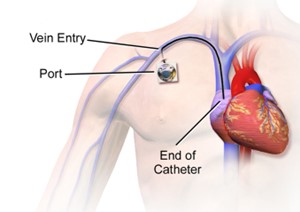A nurse is to administer Dobutamine (Dobutrex) 2.5 mcg/kg/min IV to a patient with severe heart failure who weighs 130 pounds. The pharmacy prepares a solution of 250 mg of Dobutrex in 500 mL D5W. How many mL of the medication should be administered to the patient per hour? Round your answer to the nearest whole number.
The Correct Answer is ["18"]
Step 1: Convert the patient's weight from pounds to kilograms. 130 pounds ÷ 2.205 (1 pound = 0.453592 kilograms) ≈ 58.97 kilograms
Step 2: Calculate the total dosage of Dobutamine required per hour based on the weight-specific dose. 2.5 mcg/kg/min × 58.97 kg = 147.425 mcg/min
Step 3: Calculate the infusion rate (mL/hr) using the concentration of Dobutamine in the prepared solution. The solution contains 250 mg of Dobutamine in 500 mL, which means there are 250,000 mcg of Dobutamine in 500 mL. To determine the mL/hr, divide the required dosage (147.425 mcg/min) by the amount of Dobutamine in 500 mL (250,000 mcg) and multiply by 500 mL (volume of the solution).
(147.425 mcg/min ÷ 250,000 mcg) × 500 mL ≈ 0.295 mL/min
To get the mL/hr, we convert the rate from minutes to hours (60 minutes = 1 hour):
0.295 mL/min × 60 min/hr ≈ 17.7 mL/hr
Round the answer to the nearest whole number:
Approximately 18 mL/hr of Dobutamine should be administered to the patient.
Nursing Test Bank
Naxlex Comprehensive Predictor Exams
Related Questions
Correct Answer is A
Explanation
The increased respiratory rate and pulse rate can be indicators of physiological changes or potential complications in the patient's condition. These changes may suggest alterations in tissue perfusion or other underlying issues that require further assessment.
Assessing the patient's tissue perfusion includes evaluating additional vital signs, such as blood pressure, oxygen saturation, and capillary refill time. Assessing skin color, temperature, and moisture, as well as peripheral pulses, can also provide important information regarding tissue perfusion.
B. Pain medication (option B) is incorrect because the increased respiratory and pulse rates could also indicate other factors that require assessment before administering pain medication.
C. Documenting the findings in the patient's chart (option C) is incorrect because it should not be the primary action at this point. Assessing the patient's condition and determining appropriate interventions take priority.
D. Increasing the rate of the patient's IV infusion (option D) is incorrect because may not be the most appropriate action without further assessment. The patient's increased respiratory and pulse rates may not necessarily be related to hydration status, and it is important to assess the patient comprehensively before making changes to the IV infusion rate.
Therefore, the best action by the nurse in this situation is to further assess the patient's tissue perfusion to gather more information and determine the appropriate course of action.
Correct Answer is B
Explanation
Central venous pressure (CVP) is a measurement of the pressure in the central veins, which reflects the blood volume and right-sided cardiac function. High CVP readings may indicate fluid overload or impaired cardiac function, and intervention is necessary to address the underlying cause.
Administering IV diuretic medications can help reduce fluid volume by increasing urine output and promoting fluid elimination. By removing excess fluid, the diuretic medications can help lower the CVP and alleviate the high pressures.
The other options mentioned are not the anticipated actions for addressing high CVP:
A. Increasing the IV fluid infusion rate in (option A) is incorrect because: If the CVP is already indicating high pressures, increasing the IV fluid infusion rate would further contribute to fluid overload and exacerbate the problem. This action would not be appropriate for high CVP readings.
C. Elevating the head of the patient's bed to 45 degrees in (option C) is incorrect because Positioning the patient with the head of the bed elevated is commonly done to prevent complications such as aspiration or improve respiratory function. While it may have other benefits, it does not directly address the high CVP.
D. Documenting the CVP and continuing to monitor in (option D) is incorrect because Documenting the CVP and continuing to monitor is important for ongoing assessment and evaluation. However, in the presence of high CVP readings, intervention is necessary to address the underlying issue rather than solely documenting and monitoring.
Therefore, when a patient's CVP monitor indicates high pressures following surgery, the nurse would anticipate administering IV diuretic medications to help reduce fluid volume and lower the CVP.

Whether you are a student looking to ace your exams or a practicing nurse seeking to enhance your expertise , our nursing education contents will empower you with the confidence and competence to make a difference in the lives of patients and become a respected leader in the healthcare field.
Visit Naxlex, invest in your future and unlock endless possibilities with our unparalleled nursing education contents today
Report Wrong Answer on the Current Question
Do you disagree with the answer? If yes, what is your expected answer? Explain.
Kindly be descriptive with the issue you are facing.
